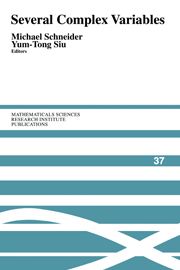Book contents
- Frontmatter
- Contents
- Preface
- Local Holomorphic Equivalence of Real Analytic Submanifolds in ℂN
- How to Use the Cycle Space in Complex Geometry
- Resolution of Singularities
- Global Regularity of the ∂-Neumann Problem: A Survey of the L2-Sobolev Theory
- Recent Developments in the Classification Theory of Compact Kahler Manifolds
- Remarks on Global Irregularity in the ∂-Neumann Problem
- Subelliptic Estimates and Finite Type
- Pseudoconvex-Concave Duality and Regularization of Currents
- Complex Dynamics in Higher Dimension
- Attractors in ℙ2
- Analytic Hilbert Quotients
- Varieties of Minimal Rational Tangents on Uniruled Projective Manifolds
- Recent Developments in Seiberg-Witten Theory and Complex Geometry
- Recent Techniques in Hyperbolicity Problems
- Rigidity Theorems in Kahler Geometry and Fundamental Groups of Varieties
- Nevanlinna Theory and Diophantine Approximation
Complex Dynamics in Higher Dimension
Published online by Cambridge University Press: 25 June 2025
- Frontmatter
- Contents
- Preface
- Local Holomorphic Equivalence of Real Analytic Submanifolds in ℂN
- How to Use the Cycle Space in Complex Geometry
- Resolution of Singularities
- Global Regularity of the ∂-Neumann Problem: A Survey of the L2-Sobolev Theory
- Recent Developments in the Classification Theory of Compact Kahler Manifolds
- Remarks on Global Irregularity in the ∂-Neumann Problem
- Subelliptic Estimates and Finite Type
- Pseudoconvex-Concave Duality and Regularization of Currents
- Complex Dynamics in Higher Dimension
- Attractors in ℙ2
- Analytic Hilbert Quotients
- Varieties of Minimal Rational Tangents on Uniruled Projective Manifolds
- Recent Developments in Seiberg-Witten Theory and Complex Geometry
- Recent Techniques in Hyperbolicity Problems
- Rigidity Theorems in Kahler Geometry and Fundamental Groups of Varieties
- Nevanlinna Theory and Diophantine Approximation
Summary
1. Introduction
In this paper we discuss low-dimensional dynamical systems described by complex numbers. There is a parallel theory for real numbers. The real numbers have the advantage of being more directly tuned to describing real-life systems. However, complex numbers offer additional regularity and besides, real systems usually complexify in a way that makes phenomena more clear: for example, periodic points disappear under parameter changes in the real case, but remain in the complex case.
In the case of the solar system and other complicated systems, one has to resign oneself to studying the time evolution of a small number of variables, since if one wants to precisely predict long-term evolution one runs into unsurmountable computer problems. One cannot forget unavoidable errors that are just necessary limits of knowledge. And some knowledge is hence limited to a phenomenological type.
Here we give a brief overview of some of the open questions in the area of complex dynamics in dimension 2 or more. We also discuss some new results by the authors about symplectic geometry and Hamiltonian mechanics, belonging to higher-dimensional complex dynamics.
2. Questions in Higher-Dimensional Complex Dynamics
Complex dynamics in one complex dimension arose in the end of the last century as an outgrowth of studies of Newton's method and the three body problem in celestial mechanics. See [Alexander 1994] for a historical treatment.
2.1. Local Theory. In the local theory one studies the behavior near a fixed point, f(x) = x. This was the beginning of the theory in one complex variable: see [Schröder 1871].
Information
- Type
- Chapter
- Information
- Several Complex Variables , pp. 273 - 296Publisher: Cambridge University PressPrint publication year: 2000
